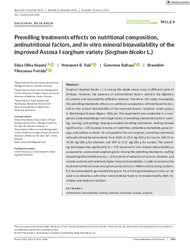| dc.contributor.author | Keyata, Ebisa Olika | |
| dc.contributor.author | Tola, Yetenayet B. | |
| dc.contributor.author | Bultosa, Geremew | |
| dc.contributor.author | Forsido, Sirawdink Fikreyesus | |
| dc.date.accessioned | 2022-05-27T12:40:01Z | |
| dc.date.available | 2022-05-27T12:40:01Z | |
| dc.date.issued | 2021-02-03 | |
| dc.identifier.citation | Keyata, E. O., Tola, Y. B., Bultosa, G., & Forsido, S. F. (2021). Premilling treatments effects on nutritional composition, antinutritional factors, and in vitro mineral bioavailability of the improved Assosa I sorghum variety (Sorghum bicolor L.). Food Science & Nutrition, 9(4), 1929-1938. | en_US |
| dc.identifier.issn | 2048-7177 | |
| dc.identifier.uri | http://onlinelibrary.wiley.com/journal/10.1002/%28ISSN%292048-7177/ | |
| dc.identifier.uri | https://doaj.org/toc/2048-7177 | |
| dc.identifier.uri | https://doi.org/10.1002/fsn3.2155 | |
| dc.identifier.uri | https://hdl.handle.net/13049/471 | |
| dc.description | All Food Science & Nutrition articles are published under the terms of the Creative Commons Attribution License | en_US |
| dc.description.abstract | Sorghum (Sorghum bicolor L.) is among the staple cereal crops in different parts of Ethiopia. However, the presence of antinutritional factors restricts the digestion of proteins and bioavailability different minerals. Therefore, this study investigates the premilling treatments effects on nutritional composition, antinutritional factors, and in vitro mineral bioavailability of the improved Assosa I sorghum variety grown in Benishangul-Gumuz Region, Ethiopia. The experiment was conducted in a completely randomized design with single factor of premilling treatments (control, washing, soaking, and malting). Among evaluated premilling treatments, malting showed significant (p < .05) increase in terms of crude fiber, utilizable carbohydrate, gross energy, and sodium contents. As compared to the raw sorghum, premilling treatments reduced antinutritional contents from 55.81 to 27.4 mg/100 g for tannin, 156.15 to 70.50 mg/100 g for phytates, and 29.9 to 3.22 mg/100 g for oxalate. The premilling techniques also significantly (p < .05) improved in vitro mineral bioavailability as compared to unprocessed sorghum grains. Among the premilling treatments, malting showed significant difference (p < .05) in terms of reduction of tannins, phytates, and oxalate contents with relatively higher mineral bioavailability. In order to enhance the food and nutritional value of sorghum particularly for children and lactating mothers, it is recommended to germinated the grains. Flour from germinated grain also can be used in combination with other nutrient-dense foods to formulate healthy diets for children and maternal nutrition. | en_US |
| dc.language.iso | en | en_US |
| dc.publisher | Wiley Online Library | en_US |
| dc.relation.ispartofseries | Food Science & Nutrition;9(4), 1929-1938. | |
| dc.subject | Antinutrients | en_US |
| dc.subject | Bioavailability | en_US |
| dc.subject | Malting | en_US |
| dc.subject | Minerals | en_US |
| dc.subject | Proximate | en_US |
| dc.subject | Soaking | en_US |
| dc.subject | Sorghum | en_US |
| dc.title | Premilling treatments effects on nutritional composition, antinutritional factors, and in vitro mineral bioavailability of the improved Assosa I sorghum variety (Sorghum bicolor L.). | en_US |
| dc.type | Article | en_US |

